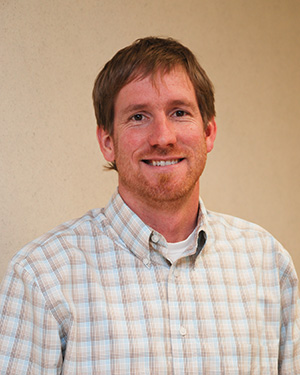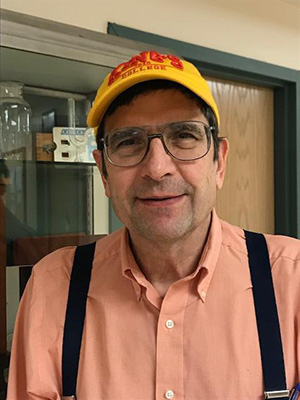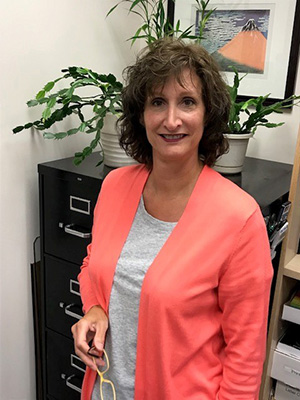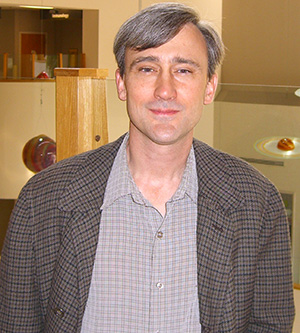Full-Time Faculty
 |
Dr. Tammy Tintjer Associate Professor of Biology Department Chair Office: Parente 311 Phone: 570-208-5900 x8102 E-mail: tammytintjer@kings.edu Read BioEducational Background B.S. Biology/Environmental Science, Auburn University at Montgomery, AL 1995 Ph.D. Ecology and Evolutionary Biology/Minor: Plant Sciences. Indiana University, Bloomington, IN 2005 Courses Taught
Research Interests In particular I study the symbiosis between grasses and systemic fungal endophytes (family: Clavicipitaceae). In many cool season grasses these fungi live intercellularly within the above-ground portions of grass tissue. The fungal endophyte can spread by spores to new grass hosts horizontal transmission. The fungus can also grow into the grass seeds and spread to the next generation of the grass vertical transmission. One goal of my research is to understand the relationship between the transmission mode of the endophyte and the evolution of virulence, or harm to the host. The fungal endophyte often produces secondary metabolitesvarious classes of alkaloids that can negatively affect grass herbivores and thus help to protect the grass from being eaten. Another goal of my research is to understand the ecological consequences of this plant-fungus symbiosis including effects on the host's distribution, population dynamics, and community interactions and structure. Currently in the lab we are developing and refining a bioassays, including one using brine shrimp (a.k.a sea monkeys) to detect the anti-herbivore bioactivity of the fungal endophyte. Recent Conference Presentations Fink, O. and T. Tintjer. 2018. Fungal endophyte effect on Spodoptera frugiperda feeding on Agrostis hyemalis compared with results of the brine shrimp bioassay. Conference presentation at the 10th International Symposium of Fungal Endophytes in Grasses Salamanca, Spain Fink, O. and T. Tintjer. 2016. Fungal Endophyte Harms Fall Armyworm, Spodoptera frugiperda, larvae feeding on the grass Agrostis hyemalis. Poster presented at the 2016 Meeting of Mid-Atlantic Chapter of the Ecological Society of America. Kutztown University of Pennsylvania T. Tintjer. 2015. Application of the brine shrimp lethality assay to detect the bioactivity of the endophyte-infected grass (Agrostis hyemalis). Conference presentation at the 9th International Symposium of Fungal Endophytes in Grasses, LaTrobe University, Melbourne Australia Kolbeck, M. and T. Tintjer. 2015. Use of a brine shrimp (Artemia salina) assay to evaluate endophyte-infected Agrostis hyemalis toxicity. Poster presented at the 90th Annual Meeting of the Pennsylvania Academy of Science, Lebanon Valley College, Annville, PA Leger, A. and T. Tintjer. 2015. Success Rate and Effects on Growth of Artificial Combinations of Cool Season Grasses and Strains of Fungal Endophytes. Poster presented at the 90th Annual Meeting of the Pennsylvania Academy of Science, Lebanon Valley College, Annville, PA Hippeli, S. and T. Tintjer. 2014. The Role of the Endophyte Neotyphodium coenophialum in the invasive properties of Festuca arundinacea through Soil Community Feedback. Poster presented at 90th meeting of the Pennsylvania Academy of Science, Susquehanna University, Selinsgrove, PA Custer, G., T. Tintjer, and J. Belanger. 2014. Assessment of Protection of Host Tissues by Vertically Transmitted Fungal Endophytes. Poster presented at the 90th Annual Meeting of the Pennsylvania Academy of Science, Susquehanna University, Selinsgrove, PA Barna, L. and T. Tintjer. 2013. Longitudinal Study of Foraging Preferences of Castor canadensis in a Leatherleaf-Sedge Wetland Habitat. Poster presented at the 89th Annual Meeting of the Pennsylvania Academy of Science, University of Pittsburgh-Bradford, Bradford, PA Barna, L. and T. Tintjer. 2012. Foraging Preferences of Castor canadensis in a Leatherleaf-sedge Wetland Habitat. Poster presented at the 88th Annual Meeting of the Pennsylvania Academy of Science, Cedar Crest College. Allentown, PA Publications Kolbeck, M. and T. Tintjer. 2016. The use of a brine shrimp assay to detect bioactivity in the endophyte-infected grass, Agrostis hyemalis Journal of the Pennsylvania Academy of Science. 90(1): 13-20 Tintjer, T., Leuchtmann, A. and Clay, K. 2008. Variation in horizontal and vertical transmission of the endophyte Epichlo elymi infecting the grass Elymus hystrix. New Phytologist. 179: 236-245. Tintjer, T. and J. A. Rudgers. 2006. Grass herbivore interactions altered by strains of a native endophyte. New Phytologist. 170: 513-521. Clay, K., Reinhart, K., Rudgers, J., Tintjer, T., Koslow, J. and S. L. Flory. 2008. Red queen communities. Pp. 145-178, In Ecology of Infectious Diseases: Interactions between diseases and ecosystems. (V. Eviner, F. Keesing and R. Ostfeld, Eds.). Princeton University Press, Princeton. Flory, S.L., E. Ingram, B. Heidinger, T. Tintjer. 2005. Hands On in the Non-Laboratory Classroom: Reconstructing Plant Phylogenies Using Morphological Characters. The American Biology Teacher 67(9):542-547. White, J. F. Jr., T. E. Drake (Tintjer) and T. I. Martin. 1996. Endophyte-host associations in grasses: XXIII. A study of two species of Balansia that form stromata on nodes of grasses. Mycologia 88 (1): 89-97. |
 |
Dr. Garrett Barr Associate Professor of Biology Office: Parente 309 Phone: 570-208-5900 x5729 E-mail: garrettbarr@kings.edu Read BioEducational Background B.S., Biology, Binghamton University, 1995 M.S., Natural Resources: Wildlife Ecology, University of New Hampshire, 2000
Ph.D., Natural Resources and Environmental Science, University of New Hampshire, 2007
Courses Taught
Research Interests I am a community ecologist and primarily study interactions among fish, salamanders, and macroinvertebrates in small streams. My interest in aquatic ecology sort of started with a love of mountains (White Mountain National Forest in NH), and I was quickly captured by the interesting interactions among predators and prey in streams. All organisms are consumers but are also consumed by others. For example, stream salamander larvae actively search for invertebrate prey while trying to avoid becoming prey to larger invertebrates, other salamanders, and fish. These tradeoffs between gathering resources and not becoming a resource for another organism can be fascinating at the individual, population, or community levels. I am also investigating some aspects of environmental degradation in the region. One big and obvious source of pollution to local surface water is abandoned mine drainage. I’ve been studying the effects of the Old Forge Bore Hole on water and habitat quality in the Lackawanna River. The mine drainage has clear impacts on the Lackawanna River, but habitat and water quality are not good up-river of the bore hole. This has led me to study degradation along the length of the Lackawanna. I’ve also been studying the effects of acidification (sort of the old acid rain issue) in local conservation lands. The occurrence and effects of acidification across the northeastern US aren’t new, but I stumbled across the issue while looking for field sites for other projects. I often look for streams with waterfalls to study because (they’re beautiful places, and) they can be great sites to study the effects of predators in streams. I found some streams with big, beautiful waterfalls that are effective barriers to fish movement. In the fishless reaches above the falls, I found very few salamanders where they should be thriving. Chronic and episodic acidification (due to a combination of atmospheric deposition, geology, and wetlands) seem to be important issues in these streams, and I’m study their impacts on fish, salamanders, and macroinvertebrates. Recent Conference Presentations with Students Laird, A and G Barr 2014. Tracking Digestion in Larval Two-Lined Salamanders with Fluorescently Marked Prey. Poster presented at the 90th Annual Meeting of the Pennsylvania Academy of Science. Madden, S and G Barr 2014. Effects of Marking Larval Salamanders on Their Survival in the Presence of Trout and Crayfish. Poster presented at the 90th Annual Meeting of the Pennsylvania Academy of Science. Minier, S and G Barr 2014. Chronic and Episodic Acidification of Fishing Creek: Effects on Two-lined Salamander Abundance. Poster presented at the 90th Annual Meeting of the Pennsylvania Academy of Science. Sohle, B and G Barr 2013. Use of Cover by Prey in Response to Single and Multiple Predator Species. Poster presented at the 89th Annual Meeting of the Pennsylvania Academy of Science. Bauza, J, B Sohle, and G Barr 2012. Anti-Predator Behavior Exhibited by Stream Macroinvertebrates When Exposed to Multiple Predators. Poster presented at the 88th Annual Meeting of the Pennsylvania Academy of Science. Stavish, G and Garrett Barr 2012. Effects of Fish on the Feeding Habits of Salamanders in Streams. Poster presented at the 88th Annual Meeting of the Pennsylvania Academy of Science. Rafter JL* and GE Barr 2010 Impacts of stocking trout on resident fish and benthic macroinvertebrates in streams in Northeastern PA. Poster presented at the 95th Annual Meeting of the Ecological Society of America. Pittsburg, PA. Publications
|
 |
Dr. David Glick Professor of Biology Office: Parente 308 Phone: 570-208-5900 x5622 E-mail: davidglick@kings.edu Read BioEducational Background Courses Taught Research Interests I am currently doing research with students on the existence of nanobacteria. These very small bacteria were, at one time, thought to exist and were in electron micrographs. Most microbiologists now believe that nanobacteria are actually artifacts and are simply minerals that have precipitated but have the same shape and size of very small bacteria. So far, my students and I have also not been able to confirm the existence of true, living nanobacteria. I am also doing research on how a non-pathogenic bacteria becomes pathogenic. I am working with students on trying to convert non-pathogenic bacteria, found on the surface of carrots, into a pathogenic bacteria that can cause damage to the carrots. So far we have not succeeded in transforming a non-pathogenic bacteria into a pathogenic one. We will continue to set up conditions that might stimulate a bacteria to evolve to a pathogenic state. Finally, I also work with students on improving labs for Microbiology and Immunology. A current example is the work three students did to develop an Immunology lab that demonstrated the activation of human T cells. Recent Conference Presentations with Students
Publications
|
| Dr. Dawn Kaufman Assistant Professor of Biology Office: Parente 306 Phone: 570-208-5900 x5724 Email: dawnkaufman@kings.edu |
|
| Dr. Brian Mangan Office: Environmental Building Phone: x5799 brianmangan@kings.edu |
|
 |
Mrs. Valerie Musto, Biology Laboratory Director Phone: 570-208-5900 x5725 E-mail: valeriemusto@kings.edu |
 |
Professor Mary Sanders Office: Parente 305 Phone: 570-208-5900 x5731 marysanders@kings.edu |
 |
Dr. Frank J. Varriale Associate Professor of Biology Office: Mulligan 310 Phone: 570-208-5900 x5768 E-mail: frankvarriale@kings.edu Read BioEducational Background Courses Taught
Recent Conference Presentations (* signifies student coauthor)
Publications |
 |
Dr. Keith Vosseller Visiting Assistant Professor of Biology Office: Parente 110 Phone: 570-208-5726 E-mail: keithvosseller@kings.edu Read BioEducational Background B.A. Biology, Miami University (Ohio). Ph.D. Molecular Biology, Cornell Post-doctoral fellowship, Johns Hopkins; Novel cytoplasmic glycosylation of proteins in signal transduction.
Research Interests Selected Publications Ma Z, Chalkley RJ, Vosseller K. Hyper-O-GlcNAcylation activates nuclear factor κ-light-chain-enhancer of activated B cells (NF-κB) signaling through interplay with phosphorylation and acetylation. J Biol Chem. 2017 Jun 2;292(22):9150-9163. Ma Z, Vosseller K. Cancer Metabolism and Elevated O-GlcNAc in Oncogenic Signaling. J Biol Chem. 2014 Dec 12;289(50):34457-34465. Skorobogatko Y, Landicho A, Chalkley RJ, Kossenkov AV, Gallo G, Vosseller K. O-GlcNAc site Thr87 regulates synapsin I localization to synapses and size of the reserve pool of synaptic vesicles. J Biol Chem. 2014 Feb 7;289(6):3602-12. Ma Z, Vosseller K. O-GlcNAc in cancer biology. Amino Acids. 2013 Oct;45(4):719-33. doi: 10.1007/s00726-013-1543-8. Ma Z, Vocadlo DJ, Vosseller K. Hyper-O-GlcNAcylation is anti-apoptotic and maintains constitutive NF-κB activity in pancreatic cancer cells. J Biol Chem. 2013 May 24;288(21):15121-30. Ma ZY, Skorobogatko Y, Vosseller K. Tandem lectin weak affinity chromatography for glycoprotein enrichment. Methods Mol Biol. 2013;951:21-31. Yuzwa, S.A., Shan, X., Macauley, M.S., Skorobogatko, Y., Vosseller, K., and Vocadlo, D.J. Glycosylation attenuates tau aggregation and slows neurodegeneration in a tauopathy mouse model. Nature Chemical Biology, 2012 Feb 26;8(4):393-9. Lynch TP, Ferrer CM, Jackson SR, Shahriari KS, Vosseller K, Reginato MJ. Critical role of O-Linked β-N-acetylglucosamine transferase in prostate cancer invasion, angiogenesis, and metastasis. J Biol Chem. 2012 Mar 30;287(14):11070-81. Yuzwa SA, Shan X, Macauley MS, Clark T, Skorobogatko Y, Vosseller K, Vocadlo DJ. Increasing O-GlcNAc slows neurodegeneration and stabilizes tau against aggregation. Nat Chem Biol. 2012 Feb 26;8(4):393-9. Zachara, N.E., Vosseller, K., Hart, G.W. Detection and analysis of proteins modified by o-linked N-acetylglucosamine. Curr Protoc Protein Sci., Chapter 12: Unit 12.8. PubMed PMID: 22045558, 2011. Zachara, N.E., Vosseller, K., Hart, G.W. Detection and analysis of proteins modified by O-linked N-acetylglucosamine. Curr Protoc Mol Biol., Chapter 17: Unit 17.6. PubMed PMID: 21732316, 2011. Yuzwa, S.A., Yadav, A.K., Skorobogatko, Y., Clark, T., Vosseller, K., Vocadlo, D.J. Mapping O-GlcNAc modification sites on tau and generation of a site-specific O-GlcNAc tau antibody. Amino Acids; 40(3):857-68. 2011 Skorobogatko, Y.V., Deuso, J., Adolf-Bryfogle, J., Nowak, M.G., Gong, Y., Lippa, C.F., Vosseller, K. Human Alzheimer's disease synaptic O-GlcNAc site mapping and iTRAQ expression proteomics with ion trap mass spectrometry. Amino Acids, 40(3):765-79. Epub 2010 Jun 19. PubMed PMID: 20563614, 2010. Caldwell, S.A., Jackson, S.R., Shahriari, K.S., Lynch, T.P., Sethi, G., Walker, S., Vosseller, K., Reginato, M.J. Nutrient sensor O-GlcNAc transferase regulates breast cancer tumorigenesis through targeting of the oncogenic transcription factor FoxM1. Oncogene, 29(19):2831-42. 2010 Francisco, H., Kollins, K., Varghis, N., Vocadlo, D., Vosseller, K., Gallo, G. O-GLcNAc post-translational modifications regulate the entry of neurons into an axon branching program. Dev Neurobiol., 69(2-3):162-73. 2009 Tallent, M.K., Varghis, N., Skorobogatko, Y., Hernandez-Cuebas, L., Whelan, K., Vocadlo, D.J., Vosseller, K. In vivo modulation of O-GlcNAc levels regulates hippocampal synaptic plasticity through interplay with phosphorylation. J Biol Chem., 284(1):174-81. 2009 Savage, P.A., Vosseller, K., Kang, C., Larimore, K., Riedel, E., Wojnoonski, K., Jungbluth, A.A., Allison, J.P. Recognition of a ubiquitous self-antigen by prostate cancer-infiltrating CD8+ T lymphocytes. Science, 319(5860):215-20. 2008 Vosseller, K. Proteomics of Alzheimer's disease: Unveiling protein dysregulation in complex neuronal systems. Proteomics Clin Appl., (11):1351-61. 2007 Vosseller, K., Trinidad, J.C, Chalkley, R.J., Specht, C.G., Thalhammer, A., Lynn, A.J., Snedecor, J.O., Guan, S., Medzihradszky, K.F., Maltby, D.A., Schoepfer, R., Burlingame, A.L. O-linked N-acetylglucosamine proteomics of postsynaptic density preparations using lectin weak affinity chromatography and mass spectrometry. Mol Cell Proteomics, 5(5):923-34. 2006 Slawson, C., Zachara, N.E., Vosseller, K., Cheung, W.D., Lane, M.D., Hart, G.W. Perturbations in O-linked beta-N-acetylglucosamine protein modification cause severe defects in mitotic progression and cytokinesis. J Biol Chem., 280(38):32944-56. 2005 Vosseller, K., Hansen, K.C., Chalkley, R.J., Trinidad, J.C., Wells, L., Hart, G.W., Burlingame, A.L. Quantitative analysis of both protein expression and serine/threonine post-translational modifications through stable isotope labeling with dithiothreitol. Proteomics, 5(2):388-98. 2005 Wells, L., Vosseller, K., Hart, G.W. A role for N-acetylglucosamine as a nutrient sensor and mediator of insulin resistance. Cell Mol Life Sci., (2):222-8. Review. 2003. Vosseller, K., Sakabe, K., Wells, L., Hart, G.W. Diverse regulation of protein function by O-GlcNAc: a nuclear and cytoplasmic carbohydrate post-translational modification. Curr Opin Chem Biol., (6):851-7. Review. PubMed PMID:12470741, 2002. Wells, L., Vosseller, K., Cole, R.N., Cronshaw, J.M., Matunis, M.J., Hart, G.W. Mapping sites of O-GlcNAc modification using affinity tags for serine and threonine post-translational modifications. Mol Cell Proteomics, 1(10):791-804, 2002. Vosseller, K., Wells, L., Lane, M.D., Hart, G.W. Elevated nucleocytoplasmic glycosylation by O-GlcNAc results in insulin resistance associated with defects in Akt activation in 3T3-L1 adipocytes. Proc Natl Acad Sci U S A, 99(8):5313-8. 2002. Wells, L., Gao, Y., Mahoney, J.A., Vosseller, K., Chen, C., Rosen, A., Hart, G.W. Dynamic O-glycosylation of nuclear and cytosolic proteins: further characterization of the nucleocytoplasmic beta-N-acetylglucosaminidase, O-GlcNAcase. 2002. Vosseller, K., Wells, L., Hart, G.W. Nucleocytoplasmic O-glycosylation: O-GlcNAc and functional proteomics. Biochimie., 83(7):575-81. 2001. Comer, F.I.,Vosseller, K., Wells, L., Accavitti, M.A., Hart, G.W. Characterization of a mouse monoclonal antibody specific for O-linked N-acetylglucosamine. 2001. Wells, L., Vosseller, K., Hart, G.W. Glycosylation of nucleocytoplasmic proteins: signal transduction and O-GlcNAc. Science, 291(5512):2376-8. 2001. |
 |
Dr. Ann Yezerski Professor of Biology Office: Parente 303 Phone: 570-208-5900 x5602 E-mail: annyezerski@kings.edu Read BioEducational Background B.A., Biopsychology, Juniata College, 1992
Biol 113 Evolution and Diversity
Do Genes Associated with Dyslexia Correlate with College Major Choice? Genetics of the Chemical Defense System of the Flour Beetle, Tribolium confusum Physiological and Behavioral Manipulation of the Rat Tapeworm, Hymenolepis diminuta, on its Intermediate and Terminal Hosts Effects of Environmental Levels of Drugs and Their Metabolites on the Physiology of Frogs
Claire Jones. Pennsylvania Academy of Science Annual Conference (2018). "Single Nucleotide Polymorphisms (SNP's) associated with dyslexia may influence college major choice in the King's College community." Nicholas Saccone. Pennsylvania Academy of Science Annual Conference (2017). "Some dyslexia-associated SNP's correlate with college major choice." Association for Biology Laboratory Education: Annual Conference (2011). New Mexico State University, NM. "Using microfossils to teach ecology and evolution." International Conference on Antimicrobials: Annual Meeting (2010). Valladolid, Spain. "Benzoquinones secreted by Tribolium beetles found to be selective antimicrobials"
Yezerski, Ann, Y. Luyten*, T. Dubiel*. (In Review). "Comparison of the effects of multiple variables on the levels of infection of the rat tapeworm, Hymenolepis diminuta, in its intermediate host, the confused flour beetle Tribolium confusum" Environmental Parasitology. Yezerski, A. (2014). "The Great Larva Race: Using Fruit Fly Larval Speed to Study Quantitative Genetics." Page 413, in Tested Studies for Laboratory Teaching, Volume 35 (K. McMahon, Editor). Proceedings of the 35th Conference of the Association for Biology Laboratory Education (ABLE), 477 pages Yezerski, A. (2013). "Genetic Variations That May Increase Your Resistance to Malaria." Pages 290-300, in Tested Studies for Laboratory Teaching, Volume 34 (K. McMahon, Editor). Proceedings of the 34th Conference of the Association for Biology Laboratory Education (ABLE), 499 pages. Yezerski, A. (2012). "Using Microfossils to Demonstrate Ecology and Evolution: (In Memoriam of Charlie Drewes). "Tested Studies for Laboratory Teaching, Volume 33 (K. McMahon, Editor). Proceedings of the 33rd Conference of the Association for Biology Laboratory Education (ABLE), 390 pages. Yezerski, A. (2011). "Genotyping SNPs Associated With Dyslexia." Pages 225-236, in Tested Studies for Laboratory Teaching, Volume 32 (K. McMahon, Editor). Proceedings of the 32nd Conference of the Association for Biology Laboratory Education (ABLE), 445 pages. Yezerski, A., C. Ciccone*, B. Volingavage*, J. Rozitski*. (2007) "The effect of a naturally produced benozoqinone on microbes common to flour." Journal of Chemical Ecology 33:1217-1225. Yezerski, A. (2006). "Why students can learn more from bad professors." Labstracts 27(2): 1. Yezerski, A. (2005). "Molecular Genetic Linkage Mapping in Tribolium Beetles." Tested Studies for Laboratory Teaching, Virginia Tech University, Association for Biology Laboratory Education. Yezerski, A., G. Cussatt*, D. L. Glick and M. Evancho* (2005). "The effects of the presence of stored product pests on the microfauna of a flour community." Journal of Applied Microbiology 98(2): 507-515. Yezerski, A. (2005). "Putting a Grant into Practice: Molecular Genetic Linkage Mapping Can Be Done by Undergraduates!" Labstracts 26(2): 1. Yezerski, A. (2005). "Building a better student by having them build it themselves." Labstracts 27(1): 1. Yezerski, A., T. P. Gilmor and L. Stevens (2004). "Genetic analysis of benzoquinone production in Tribolium confusum." Journal of Chemical Ecology 30(5): 1034-1044. Yezerski, A., L. Stevens and J. Ametrano* (2003). "A genetic linkage map for Tribolium confusum based on Random Amplified Polymorphic DNA's (RAPD's) and Recombinant Inbred (RI) lines." Insect Molecular Biology 12(5): 517-526. Yezerski, A., T. P. Gilmor and L. Stevens (2000). "Variation in the production and distribution of substituted benzoquinone compounds among genetic strains of the confused flour beetle, Tribolium confusum." Physiological and Biochemical Zoology 73(2): 192-9. |
- Department E-mail: biology@kings.edu
- Admissions: admissions@kings.edu
- Financial Aid: finaid@kings.edu
